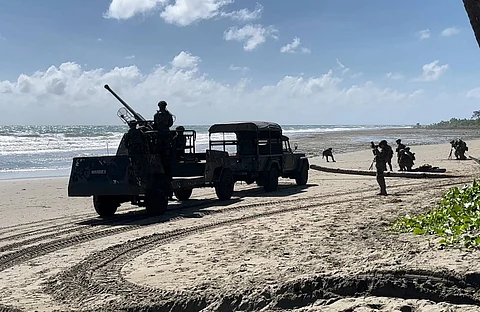
- NEWS
- the EDIT
- COMMENTARY
- BUSINESS
- LIFE
- SHOW
- ACTION
- GLOBAL GOALS
- SNAPS
- DYARYO TIRADA
- MORE

PUERTO PRINCESA CITY — Philippine and US marines showcased on Thursday their expertise in coastal defense operations, which included the integration of a special drone, as part of the 7th iteration of this year's Kaagapay ng Mandirigma mula sa Dagat (Kamandag) exercise, held at the beach of Barangay Kamuning in this city.
Approximately 95 joint troops took part in a scenario where they demonstrated the capability of a small unmanned aerial system (SUAS). This involved hand-launching the RQ-20 PUMA, a small battery-operated drone, whose mission was to conduct surveillance and gather intelligence data.
U.S. forces displayed how they responded upon detecting a presumed hostile vessel through the utilization of remote-controlled aircraft to get a closer look. Following confirmation, Philippine forces onboard armored tanks armed with mortars and anti-air guns gathered on the beach to prevent the enemy from reaching the coastlines.
Captain Philip Badrov of the Marine Rotational Force-Southeast Asia (MRF-SEA) clarified that the RQ-20 Puma stands apart from other unmanned aerial vehicles due to its lightweight nature, user-friendly operation, and the inclusion of a high-quality thermal camera.
"What we're doing here is demonstrating maritime domain awareness. So we're establishing these sensing sites with cheap, readily available radars that anyone could buy off the shelf. By having that, we have the most robust picture of the maritime domain; we're able to see everything from aggressors to anyone who is breaking the law. So this applies to everything about policing through warfare," Badrov said.
Badrov, a specialist in operating SUAS, stated that their objective is to attain interoperability between the U.S. Marine Corps (USMC) and the Philippine Marine Corps (PMC). This inter-operability not only ensures these two forces can work together as a unified entity but also enhances their relationships and proficiency in shared tactics through increased joint training, enabling effective cooperation whenever the situation demands it.
He further emphasized that the training is part of the coastal defense combined interoperability program, which is being carried out in various areas across the country as part of Kamandag 2023.
Brigadier General Antonio Mangoroban Jr., commander of the 3rd Marine Brigade (3MBde) in Palawan, explained that using equipment like the RQ-20 PUMA in coastal defense is "very important" as it enhances surveillance, response capabilities, and situational awareness while minimizing risks to human personnel and providing a cost-effective solution for safeguarding coastal regions.
"Having more equipment is better for the armed forces. Just like the PUMA, it can detect enemy or hostile forces, and then you can be alerted and react accordingly," he said.
Mangoroban said that Kamandag 7, commencing on 9 November, aims to demonstrate their collective ability to detect threats along the Philippine coastline and their corresponding response strategies.
He said that the current Kamandag iteration differs from past ones by incorporating extra equipment and permitting observers from the marines of Japan, South Korea, and the United Kingdom.
"I think it's more distinct and involves more participation among the different participants. This time, we are using different capabilities, unlike before when we were just using infantry units. Right now, we are using combined arms," he said.
Lt. Col. Steven Sprigg, the executive officer of MRF-SEA, further stressed that the exercise reaffirms the dedication of participating nations to uphold international law and promote coordination in the Indo-Pacific Region.
"To see our other partners continue to come and join with us in this exercise is very reassuring for all nations," Sprigg said.
"We just continue to build over the previous six years of Kamandag to this point here today, we stand here shoulder to shoulder and integrate our capabilities," he added.
Both Sprigg and Mangoroban refrained from addressing the West Philippine Sea issue, asserting that Kamandag 2023 is unconnected to the current developments in the disputed region, given its longstanding history of being conducted for several years.
"Coastal defense has always been a part of Kamandag Exercise, this is not in relation or in response to any kind of events. This is an annual training where we continue to execute every year so this is not directed to any current turn of events but we continue to build our capabilities as well as interoperability between our nations," Sprigg said.
"I don't think it will have any impact on the operation in WPS. We've been doing this for seven years already so it is without regard to the issues in WPS," Mangoroban added.
